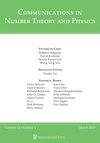关于高属弦振幅的Rankin-Selberg方法
IF 1.7
3区 数学
Q1 MATHEMATICS
引用次数: 20
摘要
闭弦在$h\leq 3$属处的振幅由西格尔模函数在西格尔上半平面的基本域上的积分给出。当被积量在尖点附近快速衰减时,可采用Rankin-Selberg方法计算积分,即在被积量中插入一个爱森斯坦级数$E_h(s)$,用轨道法计算积分,最后在$s$的合适值处提取残差。然而,弦振幅通常涉及在尖端处具有多项式甚至指数增长的积分,并且需要一种重整化方案来处理红外发散。推广Zagier对Rankin-Selberg方法在1格处的推广,给出了2次和3次在顶点附近多项式增长的Siegel模函数的Rankin-Selberg方法。特别地,我们证明了签名$(d,d)$的偶自对偶格的Siegel-Narain配分函数的重整化模积分与t对偶群$O(d,d,Z)$的$h$第一个反对称张量表示上的Langlands-Eisenstein级数的残数成正比。本文章由计算机程序翻译,如有差异,请以英文原文为准。
On the Rankin-Selberg method for higher genus string amplitudes
Closed string amplitudes at genus $h\leq 3$ are given by integrals of Siegel modular functions on a fundamental domain of the Siegel upper half-plane. When the integrand is of rapid decay near the cusps, the integral can be computed by the Rankin-Selberg method, which consists of inserting an Eisenstein series $E_h(s)$ in the integrand, computing the integral by the orbit method, and finally extracting the residue at a suitable value of $s$. String amplitudes, however, typically involve integrands with polynomial or even exponential growth at the cusps, and a renormalization scheme is required to treat infrared divergences. Generalizing Zagier's extension of the Rankin-Selberg method at genus one, we develop the Rankin-Selberg method for Siegel modular functions of degree 2 and 3 with polynomial growth near the cusps. In particular, we show that the renormalized modular integral of the Siegel-Narain partition function of an even self-dual lattice of signature $(d,d)$ is proportional to a residue of the Langlands-Eisenstein series attached to the $h$-th antisymmetric tensor representation of the T-duality group $O(d,d,Z)$.
求助全文
通过发布文献求助,成功后即可免费获取论文全文。
去求助
来源期刊

Communications in Number Theory and Physics
MATHEMATICS, APPLIED-MATHEMATICS
CiteScore
2.70
自引率
5.30%
发文量
8
审稿时长
>12 weeks
期刊介绍:
Focused on the applications of number theory in the broadest sense to theoretical physics. Offers a forum for communication among researchers in number theory and theoretical physics by publishing primarily research, review, and expository articles regarding the relationship and dynamics between the two fields.
 求助内容:
求助内容: 应助结果提醒方式:
应助结果提醒方式:


